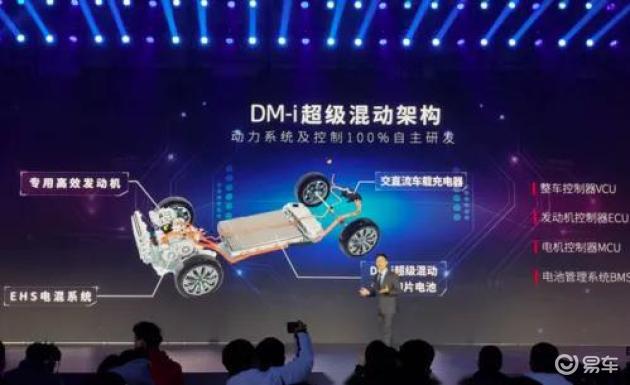In 2023, the penetration rate has exceeded 40%, and in 2024, the penetration rate is expected to reach 50%, which is to achieve the sales target of 3 million vehicles. Let’s talk about the development stage today.


In the 1990s, the THS parallel-series hybrid system developed by Toyota adopted the gear set as the power shunt structure to decide when to use oil, when to use electricity and when to mix oil and electricity, which can reduce the fuel consumption by about 40% at the highest and improve the power performance by 30%. Therefore, for a long time, there has been a saying that "there are two kinds of hybrids in the world: one is Toyota hybrid and the other is other hybrids". However, Toyota’s hybrid is still based on oil, supplemented by electricity. Toyota officially calls it "peak-cutting and valley-filling", which means cutting off excess performance for charging, and then using the stored electricity for vehicle driving to fill the part with insufficient engine efficiency. Subsequently, Toyota made this hybrid technology better and better, and set up a "patent network", which eventually became a dragon, which can be said to greatly hinder the development of hybrid technology.

The power split technology based on planetary gear sets has been set up by Toyota, which makes other car companies miserable, but Toyota is not short of money, what it wants is a monopoly. Many car companies have tried many ways to bypass Toyota, but the results are not good, such as the plug-in hybrid car F3DM introduced by BYD in 2008. However, due to the complicated control and the lack of high-efficiency engine technology, the final product is not competitive. Honda, as an old rival of Toyota, intervened in the research and development of hybrid technology in the 1990s, using the idea of "cutting peaks and filling valleys", but on the one hand, it has to bypass Toyota’s technical blockade, on the other hand, it is limited by its own execution, and the gap with Toyota is getting bigger and bigger. When the sales volume of Toyota hybrid vehicles exceeded one million, the cumulative sales volume of Honda hybrid vehicles was only about 200,000.
However, Honda, as a technical house, has opened up a new technical route-electric hybrid. Toyota uses the motor to assist the engine, and uses less oil to save fuel. Honda uses the motor as the main drive, and the engine direct drive as the auxiliary to solve the problem of low efficiency of the motor at high speed, and uses more electricity to save fuel.
Toyota goes to the left, Honda takes the world to the right.

Toyota THS system divides driving into more than ten working conditions (or more than twenty), and each working condition determines the proportion of oil and electricity distribution. Honda’s i-MMD system has only three working conditions: ①EV mode, pure electric drive; ② Hybrid mode, in which the engine generates electricity to drive the motor, and the excess electricity is stored in the battery pack; ③ Engine direct drive mode, in which the engine is driven alone. Driving in urban areas is basically that the engine is only responsible for power generation, and the engine is only involved when it is above 85kph. Because the direct drive function of the engine is weakened, i-MMD uses a smaller displacement engine and a higher power motor. Take the hybrid as an example, using a 2.0L self-priming engine, and the hybrid is a 2.5L engine. The comprehensive fuel consumption of the final output of the two is almost the same, but because the motor used is larger, it starts faster than the latter and is closer to the pure electric vehicle, and the driving experience is better. Although the i-MMD hybrid system was launched 16 years later than THS, the i-MMD system has made rapid progress. In 2019, the sales of some models have positively defeated Toyota’s similar cars.

In different road conditions, motor drive and engine drive have their own advantages. When driving at high speed, the efficiency of motor drive will gradually be lower than that of engine. Therefore, in an ideal state, the motor and engine can be driven alternately in different scenes to achieve the highest efficiency. But to achieve this effect, it is obvious that smarter power distribution is needed. Such a complex structure requires huge R&D cost and adjustment level, and the domestic new energy boss who is not bad for money, relying on more than 20 years of technology accumulation and R&D investment, took the lead in launching DM-i hybrid technology in 2020, basically solving some problems of the old hybrid technology. DM-i technology is an intelligent hybrid system that combines series technology and parallel technology, so that cars can adjust the series and parallel modes at the right time according to road conditions. In this way, the hybrid automobile can not only give full play to the economic advantages in normal times, but also keep the engine output at the most efficient speed. Therefore, many of BYD’s DM-i hybrid models are famous for their fuel economy, and the official comprehensive fuel consumption of 100 kilometers can even be below 2L.

It has attracted more and more attention around the world. On the one hand, hybrid vehicles can significantly reduce fuel consumption, thus reducing dependence and exhaust emissions, which is of great significance to environmental protection and environmental protection. On the other hand, with the breakthrough of core technologies such as batteries and motors and the reduction of costs, the economy of hybrid vehicles has also been significantly improved, making more consumers affordable.
In the future, which direction will the development of hybrid vehicles go?
?????
关于作者